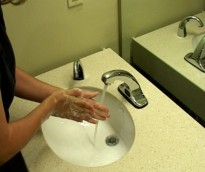
Contact our PIO directly to share health news.

770.339.4260
What is norovirus?

Norovirus is a stomach and intestinal illness that causes vomiting and diarrhea. You may hear people refer to it as the “stomach flu.” But norovirus is not related to the influenza virus, which is primarily a respiratory illness.
Every year – especially from November to March – we will see an increase in incidents of norovirus. So what are the symptoms? And what can you do to stay healthy?
The symptoms of norovirus illness usually began 12 hours to 2 days after being infected. Symptoms include nausea, vomiting, diarrhea, and headache. Severe disease such as high fever and bloody diarrhea are uncommon, but dehydration can be seen among the very young, the elderly and persons with weakened immune systems. Most people recover within 1–2 days but may continue to be contagious for as long as 2 weeks after recovery.
People can become infected with the virus by eating food or drinking liquids that have been contaminated with norviruses, touching surfaces or objects that have been contaminated with norviruses then putting their hand in their mouth, or having direct contact with someone who is ill with norovirus.
Outbreaks of norovirus infections are very common because it is extremely contagious and easily spread from person-to-person. Both stool and vomit are infectious. Outbreaks can occur in schools, daycares, and nursing homes as well as restaurants, catered events, and cruise ships. Undercooked oysters harvested from contaminated water can also be a vehicle for norovirus infection.
Norovirus is a particularly hardy virus and is resistant to most household cleaners. To kill
the virus on surfaces, you must use either a cleaner that is EPA certified to kill norovirus or a particular concentration of bleach depending on the surface to be cleaned.
Proper and frequent hand washing paired with prompt and adequate disinfection of contaminated surfaces are essential to stopping the spread of the virus.
Remember – good health starts with clean hands.
Click here to watch a short video on how to properly wash and dry your hands.
Contact our PIO directly to share health news.



